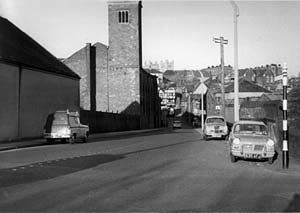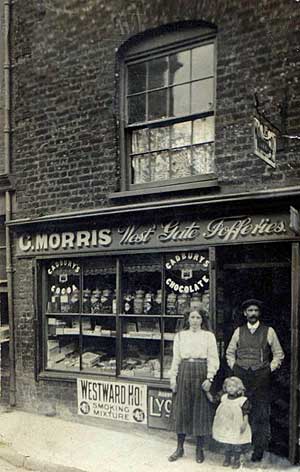
Edmund Street
Page updated 18th February 2010
 Edmund Street as a thoroughfare can be traced back to 1238 when the
first Exe Bridge was built by Nicholas and his son
Walter Gervase. A public subscription appealing to wealthy merchants
and influential citizens was raised to fund the crossing. A chapel, St
Edmund's dating from at least 1214 was incorporate into the bridge
while houses were also built along the structure.
Edmund Street as a thoroughfare can be traced back to 1238 when the
first Exe Bridge was built by Nicholas and his son
Walter Gervase. A public subscription appealing to wealthy merchants
and influential citizens was raised to fund the crossing. A chapel, St
Edmund's dating from at least 1214 was incorporate into the bridge
while houses were also built along the structure.
When the bridge was partly demolished and a replacement constructed in 1778 to the north, the eastern end of the old bridge, with St Edmund's Church, was retained and became known as Old Bridge Street. What was shallow river and marsh land to each side of this section of bridge was gradually reclaimed and built upon, while retaining the Upper and Lower Leats. The Lower Leat flowed past the Roundtree Mill and City Brewery to flow under the old bridge, at what became known as Horsepool Bridge. Before a brewery was established in the middle of the 17th Century by the bridge and the Lower Leat, the site was used for the city cuckingstool to punish women found guilty of being 'scolds' and gossips - whether this was on the bridge, or on some reclaimed land under the bridge is not certain. As Exe Island and Shilhay were developed, any vestige of the ancient, mediaeval Exe Bridge disappeared under tenement and industrial building. Many of the inhabitants obtained their water by dipping from the leat at Horsepool, leading to seven deaths from cholera in 1832.
Old Bridge Street was renamed Edmund Street in 1854, and was widened. Because of the proximity of the City Brewery, or more likely, due to a large local population, the short length of Edmund Street was home to the Commercial Inn, Queen's Head Inn, Old Teignmouth Inn and the Blue Boy Inn. City Council Sanitation Committee minutes for the years 1902 to 1905 often refer to the Blue Boy Inn, which was licensed as a common lodging house. A little above St Edmund's Church ran Frog Street to the left, and Ewings Lane to the right. Edmund Street joined West Street at the site of the old West Gate. On the Corner of Edmund Street and Frog Street could be found the early 15th Century Merchants House, that became famous in 1961, when it was dragged on rails to West Street, to be forever known as the House that Moved. During the move, the house jammed against the kerb of the Old Teignmouth Inn, and needed a man and saw to release it. The lower end of Edmund Street joined Commercial Road, just below Horsepool Bridge. Edmund Street was at the heart of the area, and would often see local carnivals and processions, sometimes with carts hauled by shire horses from the council yard at Exe Island, pass up it. It is often forgotten that Edmund Street was part of the main route for motor traffic through Exeter up to the time of the building of Western Way. From South Street, traffic turned down Coombe Street, then left at the bottom along West Street. By the site of the old West Gate it then turned left into Edmund Street, then right into Commercial Road and over the Exe Bridge. In the summer, the traffic jams must have been extensive, as cars from Bristol and the Midlands negotiated their way through the city to cross the Exe Bridge and proceed to the Torquay, Plymouth and Okehampton roads. The photograph of St Edmund's Church indicates that Edmund Street was one way in the 1960s.
The end of Edmund Street
The clearing of Shilhay and the southern part of the West Quarter in the 1960s, and early 1970s, for the building of Western Way saw Edmund Street, Frog Street and Ewings Lane disappear. As the demolition progressed, the ancient Exe Bridge was exposed and archaeologists called to investigate it. It was decided to retain the bridge and what was left of the partly demolished St Edmund's Church. Now, all that is left of this major highway, is a pleasant footpath along the old Exe Bridge, situated in the centre of a large traffic island.
World War One Dead - Edmund Street
Rifleman
Wilfrid John Hare, London Irish Rifles, 27 December 1917, aged 22, St
Edmond's Rectory
Lance Serjeant, Frank Holding, Coldstream Guards.
14 September 1914. Age 23. Parents from Edmund St
Private, F Lyons,
Worcestershire Regiment. 14 July 1916. Edmund St
Private, E Stabb,
Devonshire Regiment. 1 July 1916. Age 26. Edmund St
The 1897 directory shows the following businesses on the western side of Edmund Street from St Edmund's towards West Street.
Edmund st.
Commercial rd.
ST. EDMUND'S CHURCH
7 Densham William Adolphus
9 Densham Charles
10 Hooper Wm. fishmonger
11 Winfield Mark, greengrocer
12 Bice Samuel, general dealer
Sources: Various trade directories, Chronicles of Exeter by Todd Gray and other articles on this site.
 The Pioneer Coffee House on the corner of Edmund and Frog Street in
1961 when they moved the Merchant's House.
The Pioneer Coffee House on the corner of Edmund and Frog Street in
1961 when they moved the Merchant's House.
 A view up Edmund Street from
Horsepool showing St Edumds Church. Both photos courtesy of Dick
Passmore.
A view up Edmund Street from
Horsepool showing St Edumds Church. Both photos courtesy of Dick
Passmore.
 George
Morris outside his shop three doors below the Old Teignmouth Inn, circa
1910. Morris also ran the Old Teignmouth Inn, the Queens Head and the
Blue Boy, all within the same row of buildings in Edmund Street. He was
killed during 1918 in France. Photo courtesy of Phil Knight.
George
Morris outside his shop three doors below the Old Teignmouth Inn, circa
1910. Morris also ran the Old Teignmouth Inn, the Queens Head and the
Blue Boy, all within the same row of buildings in Edmund Street. He was
killed during 1918 in France. Photo courtesy of Phil Knight.
│ Top of Page │